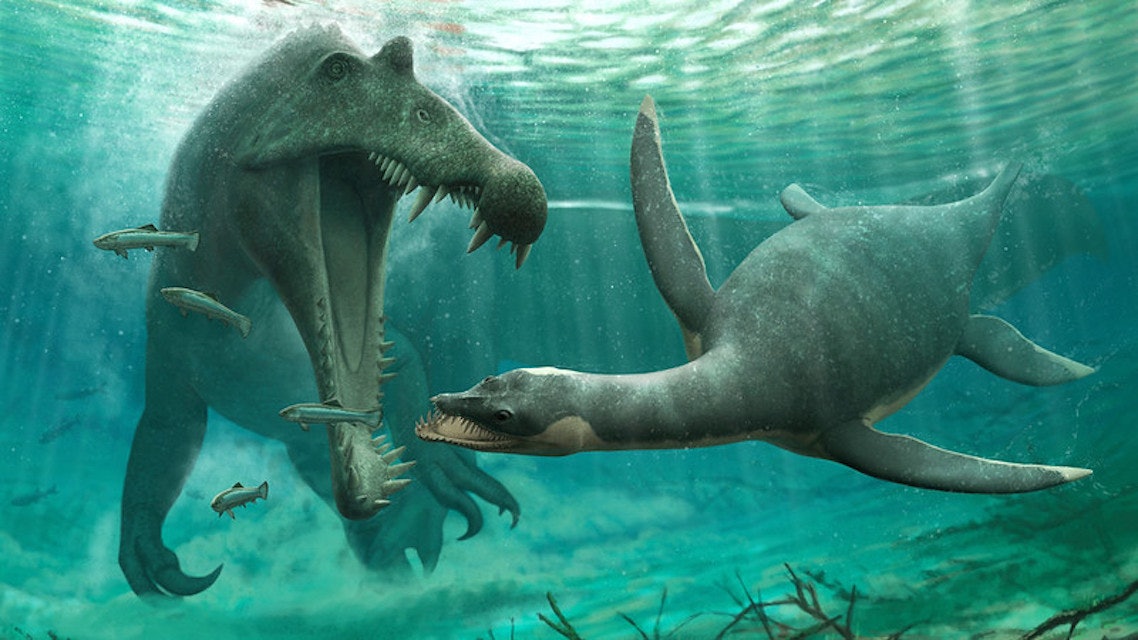
In the center of Scotland, among the highlands, a 22-mile-long, 1.6-mile-wide lake has captured the imagination of several generations of cryptozoology enthusiasts, with tales of a giant lake creature, one that has allegedly mauled boatmen in ancient times, and periodically makes “appearances” in modern times. Perhaps no creature of its ilk is as famous as the Loch Ness Monster, or, as it's often known, Nessie.
Last week, Cretaceous Research, whose name to dinosaur fans is self-explanatory, published a paper on a new fossil find: a stubby little freshwater plesiosaur. Plesiosaurs were a class of ancient marine reptiles that looked a bit like a brachiosaurus if it had a carnivorous seal relative: long necks, flippers, and sharp teeth. It was a real nightmare of a creature.

This particular specimen was a few fragmentary fossils that corresponded to a 10-foot adult and five-foot baby plesiosaur. Compare that to the Albertonectes vanderveldei, a 38-foot plesiosaur (37 minus the missing head) believed to be the longest yet found.
(As a testament to the unwieldy unusability of the internet, the search for the largest plesiosaur brings you to a low-hanging fruit site that claims an 82-foot plesiosaur, addressing a somewhat related short-necked plesiosaur in the Liopleurodon genus and tacking on 60 feet to its real size. It addresses a Guinness Book of World Records “record” that itself has no citations. This may have come from an overly-sensationalized “ancient animal” show that sounds like it just sort of made up things. But 22 feet with sharp teeth is still plenty terrifying. We here at Inverse hope our SEO serves the greater good.)
Anyway, a 10-foot plesiosaur is still terrifyingly adorable. But this one comes with a delightful little twist: It lived in freshwater, as the fossils of what’s for now being called the Kem Kem plesiosaur were found in an ancient riverbed. That’s neat! It suggests that plesiosaurs could survive in freshwater systems, or move between marine (sea or oceanic salt water) and freshwater systems. And things that are that large are disquieting but better than the alternative.
Small. Freshwater. So the University of Bath, about 550 miles south of Loch Ness, said in a press release, “But what does this all mean for the Loch Ness Monster? On one level, it’s plausible.” But that wasn’t the end of the paragraph. They went on to say, “Plesiosaurs weren’t confined to the seas, they did inhabit freshwater. But the fossil record also suggests that after almost a hundred and fifty million years, the last plesiosaurs finally died out at the same time as the dinosaurs, 66 million years ago.”
A blog post by one of the scientists who found the fossil, Nick Longrich, makes a few nods to Dune but no mention of Nessie, so it’s really falling on the public information officer behind the original press release.
But guess which one of those words the British tabloids heard and ran away with? That’s right. Plausible.
So here we are. Back in news by the headline. The University of Bath’s press release, with the headline “Plesiosaur fossils found in the Sahara suggest they weren’t just marine animals,” didn’t quite have that “plausible” punch. Freshwater plesiosaurs existed. They were small enough to fit in a river. But like the non-avian dinosaurs, they died out 66 million years ago when a devastating asteroid impact blotted out the skies and killed most megafauna as food sources were depleted.

“On one level, it’s plausible.” That level is that something once existed, the right size, in a sort of similar place. This particular group of fossils was 100 million years old, a continent away, not a specimen found under the mud of Loch Ness. Some fossilized members of its genus, Leptocleididae, have been found in England.
But time and time again, nothing turns up when scientists turn their attention to Loch Ness. Or at least no plesiosaurs — but eel DNA has been found in the waters, in an amount a one-paragraph story in Science called “surprising.”
But even that makes something in Loch Ness alive today a lot more “plausible” than an ancient fossil beyond a Rock of Gibraltar away does. And lots of people trying to prove strange creatures have ulterior motives.
In summary, get off my lawn.







